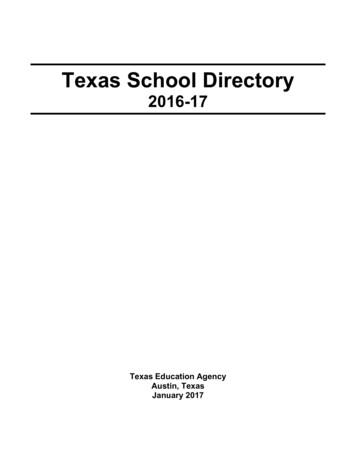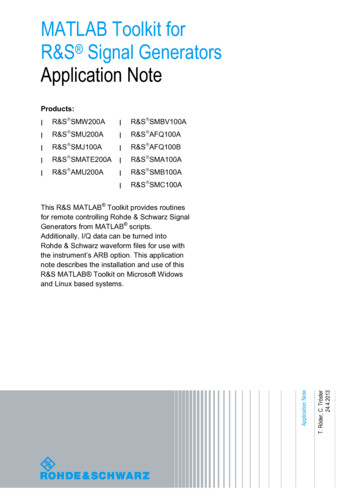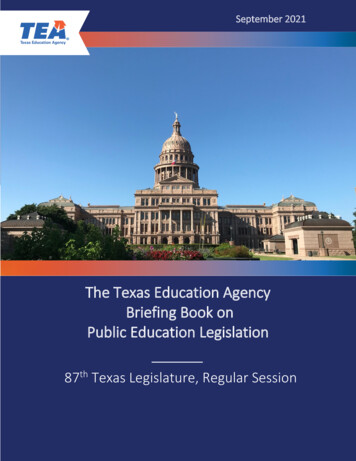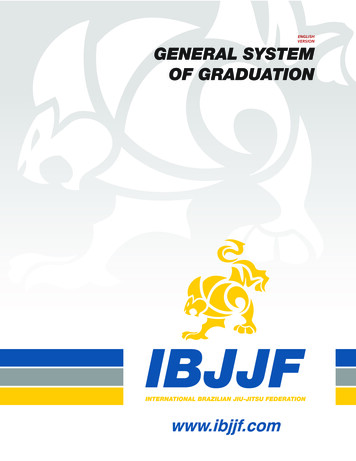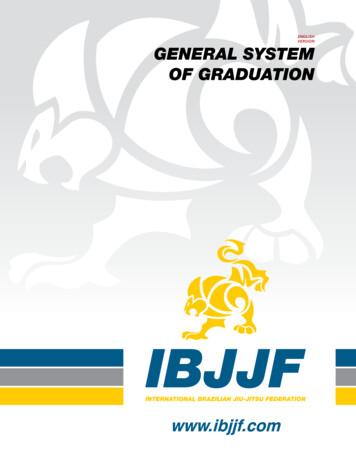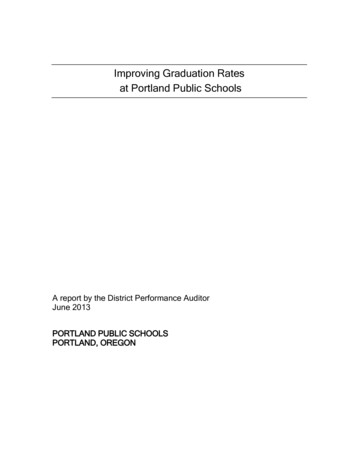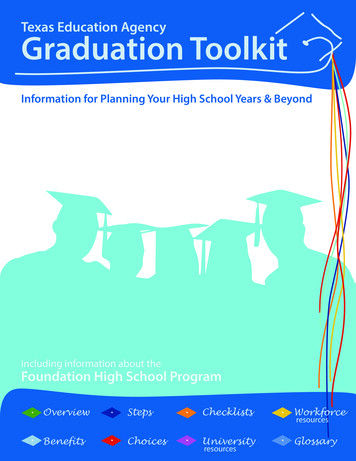
Transcription
Texas Education AgencyGraduation ToolkitInformation for Planning Your High School Years & Beyondincluding information about theFoundation High School icesUniversityGlossaryresourcesresources
Texas Education AgencyGraduation ToolkitGraduation Program - OverviewDistinguished Level of Achievement - BenefitsTexas High School Diploma - StepsEndorsements - ChoicesGraduation Program - ChecklistsInformation - University ResourcesInformation - Workforce ResourcesGraduation Program - Glossary
Texas Education Agency Graduation ToolkitGraduation Program – OverviewFoundation High School ProgramThe Foundation High School Program with endorsements is a flexible program that allows students topursue their interests. It is the default graduation program for students who entered high school in the2014-15 school year or later.The program contains up to four parts: A 22-credit foundation plan which is the core of the Texas high school diploma program Five endorsement* options that allow students to focus on a related series of courses A higher performance category called Distinguished Level of Achievement Performance Acknowledgments that note outstanding achievement in specific areas**The Foundation requirements (22 credits) include:English (4 credits) English I English II English III An advanced English courseMathematics (3 credits) Algebra I Geometry An advanced math courseScience (3 credits) Biology Integrated Physics & Chemistry or an advanced science course An advanced science courseSocial Studies (3 credits) World History or World Geography U.S. Government (one-half credit)Languages Other Than English (2 credits)Physical Education (1 credit) U.S. History Economics (one-half credit) 2 credits in the same language or 2 credits from Computer Science I, II, IIIFine Arts (1 credit)Electives (5 credits)Speech: Demonstrated proficiencyEndorsements Total credits with endorsements 26EnhancementsAdditionally, a student may earn the Distinguished Level of Achievement and/or a PerformanceAcknowledgment for outstanding performance. The Distinguished Level of Achievement must beearned to be admitted to a Texas public university under the Top 10 percent automatic admission law.Distinguished Level of AchievementPerformance Acknowledgments Areas** Foundation Program requirements dual credit courses 4 credits in math including Algebra II bilingualism and biliteracy 4 credits in science PSAT, ACT ASPIRE , SAT or ACT at least 1 endorsement Advanced Placement or International Baccalaureate exams earning a state-, nationally- or internationally-recognizedbusiness or industry certification or license*A student entering 9th grade must indicate an endorsement he or she plans to follow.A student may change or add an endorsement at any time.A student may graduate without earning an endorsement if, after his or her sophomore year,the student’s parent signs a form permitting the student to omit the endorsement requirement.BR16-130-03
Texas Education Agency Graduation ToolkitDistinguished Level of Achievement – BenefitsChoices determine optionsMost of the very best jobs available now and in the future require educationand training beyond a high school diploma. Whether you intend to pursue ahigh-demand, industry workforce credential from a community or technicalcollege or a traditional four-year degree from a university, the choices madein high school will determine your future options.To best prepare yourself now for the transition to post-high school educationor quality workforce training, choosing and taking the right classes is essential.The Distinguished Level of Achievement will ensure the best preparation foryour future.CredentialTechnicalCollegeWhy it matters — BenefitsThe Distinguished Level of Achievement opens a world of educational and employmentopportunities for you beyond high school. The Distinguished Level of Achievement will: Allow you to compete for Top 10% automatic admissions eligibility at any Texas public university; Position you among those first in line for a TEXAS Grant* to help pay for university tuition and fees; and Ensure you are a more competitive applicant at the most selective colleges and universities.*Must be financially qualifiedWhat it meansThe Distinguished Level of Achievement requires more math and more science than theFoundation High School Program. The Distinguished Level of Achievement requires: A total of four credits in math, including Algebra II; A total of four credits in science; and Successful completion of an endorsement in your area of interest.Advantages Opportunity to earn an endorsement in an area of interest More college and university options More financial aid options Better preparation for college-level coursework at community/technical colleges and universities Opportunity for immediate enrollment in classes related to your chosen field of study Strong foundation to successfully complete an industry workforce credential or college degreeTexas Education Agencytea.texas.gov thecb.state.tx.ustwc.state.tx.usBR16-130-03
Texas Education Agency Graduation ToolkitTexas High School Diploma – StepsDistinguishedLevelofAchievement26 Credits Algebra II Required Eligible for Top 10% Automatic Admissions to Texas Public Universities22 Credits for the Foundation High School ProgramRequirements of 1 Endorsement(including 4 credits in both Math and Science and 2 additional electives)STEMBusiness &IndustryPublicServicesArts &HumanitiesMultiDisciplinaryStudiesBe sure to visit your school counselor to learn more about your options.Students may earn more than one endorsement.Texas Education Agency Texas Higher Education Coordinating Board Texas Workforce CommissionBR16-130-03
Texas Education Agency Graduation ToolkitEndorsements – ChoicesEndorsementsStudents are able to earn one or more endorsements as part of their graduation requirements.Endorsements consist of a related series of courses that are grouped together by interest or skillset. They provide students with in-depth knowledge of a subject area.Students must select an endorsement* in the ninth grade. Districts and charters are not requiredto offer all endorsements. If only one endorsement is offered, it must be multidisciplinary studies.Students earn an endorsement by completing the curriculum requirements for the endorsement,including 4 credits in both math and science and 2 additional elective credits.Students can choose from 5 endorsement areasScience, Technology, Engineering and Mathematics (STEM) Career and Technical Education (CTE) courses related to STEM Mathematics Science Combination of no more than two of the categories listed above Computer ScienceBusiness and Industry (one of the following or a combination of areas) Agriculture, Food and Natural Resources Architecture and Construction Arts, Audio/Video Technology and Communication Business Management and Administration Finance Hospitality and Tourism Manufacturing Information Technology MarketingPublic Services (one of the following) Human Services Law Corrections and Security Health Science Public Safety Technology Applications Transportation, Distribution and Logistics English electives in: advanced broadcast journalism advanced journalism debate public speaking Education and Training Government and Public Administration Junior Reserve Officer Training Corps (JROTC)Arts and Humanities (one of the following) 2 levels each in two languages other than English (LOTE) Social Studies 4 levels in the same LOTE American Sign Language (ASL) Courses from one or two areas (music, theater, art, dance) in fine arts English electives not included in Business and IndustryMulti-Disciplinary Studies (one of the following) 4 advanced courses from other endorsement areas 4 credits in each foundation subject area, including English IV and chemistry and/or physics 4 credits in Advanced Placement, International Baccalaureate, or dual credit selectedfrom English, mathematics, science, social studies, economics, LOTE or fine artsENDORSEM*Visit your school counselor to learn more about your options.Students may earn more than one endorsement.ENTSBR16-130-03
Texas Education Agency Graduation ToolkitGraduation Program – Checklists8 GradethReview choices offered under the Foundation High School Program and the Endorsementsto decide on your future academic path.Select the endorsement that best fits your area of personal interest and the major youplan to study in college.Recognize that most college entrance requirements include rigorous advanced coursesincluding Algebra II, higher-level science courses and languages other than English.9 /10 GradeththMonitor high school credits; be sure to meetall local and state requirements.Explore interests and take advantage ofCareer Day opportunities.Take dual credit or Advanced Placementcourses if possible to earn college credit whilestill in high school.Attend college nights hosted by your highschool. Talk with school representativesabout the types of financial aid available.Keep list of awards, honors andextracurricular activities for scholarship andcollege applications.Take the Preliminary SAT (PSAT)/NationalMerit Scholarship Qualifying Test in yoursophomore year for practice. In your junioryear, take the PSAT for eligibility for theNational Merit Scholarship Competition.Students who take the PSAT or ACT ASPIRE tend to score higher on the SAT or ACTthan those who do not.Research colleges or universities you areinterested in attending. Check admissionand application requirements and timelines.11 /12 GradeththTake dual credit or Advanced Placement courses if possible to earn college credit whileyou are still in high school.Check with your counselor’s office to learn about available scholarships. Be sure to apply earlyand for as many scholarships as possible. Do not limit yourself to local scholarships.Consider taking SAT/ACT preparation classes. Sign up and take the ACT and/or SAT test,preferably in your junior year but no later than the fall of your senior year.Fill out the FAFSA (Free Application for Federal Student Aid) early in thespring of your senior year.Apply to college during the fall of your senior year.If you plan to pursue technical training or enter the workforce after graduation, see the Information- Workforce Resources page or visit Texas Reality Check at www.texasrealitycheck.com/.BR16-130-03
Texas Education Agency Graduation ToolkitInformation – University ResourcesResourcesFoundation High School Program with hb5.aspxIn 2013, the Texas Legislature passed House Bill 5 creating the Foundation HighSchool Program. This webpage provides an array of information including: A side-by-side comparison of the Foundation High School Program and the previousgraduation programs A Foundation High School Program Frequently Asked Questions Approved Foundation High School Program Rules — Detailed information about thestate’s graduation programCompare College TXwww.comparecollegetx.comCompare College TX is an interactive, mobile-friendly web tool designed to helpstudents and parents learn more about Texas public universities and community/technical colleges.Did you know.eligiblecreditstudents can earn college credit while still inhigh school by taking Advanced Placementcourses and earning high scores on the APtests or by enrolling in and passing dualcredit courses?earningsover their lifetime a high school graduatewith a bachelor's degree earn 84 percentmore* than a high school graduate?students ranked in the Top 10 percentof their graduating class from anaccredited public or private Texas highschool may be eligible for automaticadmission to a Texas public universityif they have completed theDistinguished Level of Achievement?tuitionthe highest ranking graduate at each Texaspublic high school receives a certificate fromthe Texas Education Agency that can be usedas a scholarship to cover tuition costs at anyTexas public college or university?*Center on Education and the Workforce, “The College Payoff: Education,*Occupations, Lifetime Earnings,” August 2011. Georgetown UniversityBR16-130-03
Texas Education Agency Graduation ToolkitInformation – Workforce ResourcesCareerIf you are considering going straight into the workforce or into a technical training program followinggraduation, you still need to complete your high school education and earn a high school diploma.While in high school, you will want to:Look at the five endorsements offered under the Foundation High School Program.Determine your area of interest.Complete your selected endorsement along with the required foundation program to earnyour high school diploma.Learn about available jobs, and any required post-high school or technical training.Explore new career opportunities.Research wage and occupation information, required levels of education andtraining requirements.Discover your interests and abilities; use labor market resources at www.texasrealitycheck.com/and at oration-trends.html.Research which jobs are among the fastest and most in-demand in Texas asp.Community College & Career SchoolsFind training and certifications for specific occupations or skills throughcommunity colleges or career schools and colleges chools-colleges.html.Did you know.trainingmany of the high-demandjobs1 will require somepostsecondary education?tuitionstudents attending communitycolleges or trade schools mayalso be eligible for state orfederal financial aid?2credentialthat Texas public school students can earn a PerformanceAcknowledgement on their transcripts by earning a state-,nationally- or internationally-recognized credential for aspecific professional occupation, such as certified nurses’aid certification (CAN) or computer tech certification (CTC)while in high school?earningsover their lifetime, high school graduates with aworkforce certificate from a community or technicalcollege earn 20 percent more3 than those with onlya high school diploma?1Texas Workforce Commission2Get the facts at www.collegeforalltexans.com or studentaid.ed.govCenter on Education and the Workforce, “Certificates: Gateway to Gainful Employment and College Degrees,”June 2012. Georgetown University33BR16-130-03
Texas Education Agency Graduation ToolkitGraduation Program – GlossaryFoundation High School ProgramThe basic 22-credit graduation program for Texas public school students.EndorsementsAreas of specialized study. The areas are: Science, Technology, Engineering and Mathematics (STEM) Business and Industry Arts and Humanities Public Services Multidisciplinary StudiesA district or charter that offers only one endorsement must offer Multidisciplinary Studies.Distinguished Level of AchievementA high level of academic achievement earned by going beyond the Foundation High SchoolProgram. It requires a total of 26 course credits, including Algebra II, a fourth science creditand an endorsement. A student must earn this designation to be eligible for Top 10 percentautomatic admission to a Texas public university.Performance AcknowledgmentsStudents may earn an additional acknowledgment on their transcripts because of outstandingperformance in areas such as dual credit courses and bilingualism and biliteracy; on AdvancedPlacement, International Baccalaureate, PSAT, ACT ASPIRE , the SAT or ACT exams; or byearning a state-, nationally- or internationally-recognized business or industry certification.Course CreditA unit of measure awarded for successful completion of a course. Completion of a onesemester course typically earns one-half credit for a student.Industry Workforce CredentialA state-, national- or internationally-recognized credential that aligns with the knowledge andskills standards identified by an association or government entity representing a particularprofession or occupation and valued by business or industry. Examples include a credentialfor certified nurse aid (CNA) or the automotive service excellence (ASE) certification in theautomotive industry.STAARState of Texas Assessments of Academic Readiness (STAAR) is the state-mandated test givenannually to students in grades 3-8 and in five high school courses.EOCSTAAR end-of-course exams are state mandated tests given during the final weeks of a highschool course. In addition to meeting graduation course requirements, students are required topass five end-of-course exams to earn a diploma from a Texas public high school. Those fiveexams are given when a student takes English I and II, Biology, Algebra I and U.S. History courses.BR16-130-03
Texas Education Agency Graduation ToolkitMy NotesMy Graduation DateBR16-130-03
Texas Education Agency1701 N. Congress AvenueAustin, Texas 78701-1494512 463-9734tea.texas.govProduced by theTexas Education Agencyin cooperation with theTexas Higher Education Coordinating Boardand theTexas Workforce CommissionBR16-130-03
22 Credits for the Foundation High School Program Requirements of 1 Endorsement (including 4 credits in both Math and Science and 2 additional electives) Texas Education Agency Texas Higher Education Coordinating Board Texas Workforce Commission Be sure to visit your school counselor to learn more about your options.

